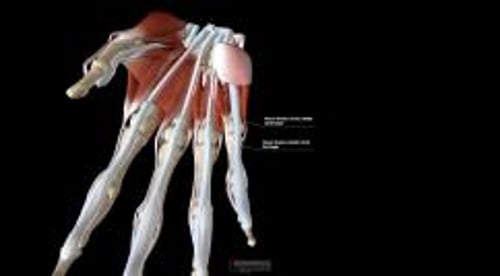Infectious flexor tenosynovitis is an acute infection within the flexor tendon sheath. Diagnosis is suggested by Kanavel signs and confirmed with radiographs. Treatment is surgical drainage and antibiotics.
(See also Overview and Evaluation of Hand Disorders.)
The usual cause of infectious flexor tenosynovitis is a penetration and bacterial inoculation of the sheath.
Diagnosis of Infectious Flexor Tenosynovitis
Kanavel signs
Radiographs
Culture of drainage or surgical sample
Infectious flexor tenosynovitis causes Kanavel signs:
Flexed resting position of the digit
Fusiform swelling
Tenderness along the flexor tendon sheath
Pain with passive extension of the digit
Radiographs should be taken to detect occult foreign bodies. Acute calcific tendinitis and rheumatoid arthritis can restrict motion and cause pain in the tendon sheath but can usually be differentiated from infectious flexor tenosynovitis by a more gradual onset and the absence of some Kanavel signs.
Disseminated gonococcal infection can cause tenosynovitis but often involves multiple joints (particularly those of the wrists, fingers, ankles, and toes), and patients often have recent fever, rash, migratory polyarthralgias, and often risk factors for a sexually transmitted disease. Infection of the tendon sheath may involve nontuberculous mycobacteria, but these infections are usually more indolent, especially in immunocompromised patients (1). History of exposure to aquarium or other standing water should be elicited to determine risk of Mycobacterium marinum infection.
Diagnosis reference
1. Kazmers NH, Fryhofer GW, Gittings D, et al: Acute deep infections of the upper extremity: The utility of obtaining atypical cultures in the presence of purulence. J Hand Surg Am 42(8):663.e1-663.e8, 2017. doi: 10.1016/j.jhsa.2017.05.004. Epub 2017 May 25. PMID: 28550986.
Treatment of Infectious Flexor Tenosynovitis
Surgical drainage and antibiotics
Treatment of infectious flexor tenosynovitis is surgical drainage (eg, irrigation of the tendon sheath by inserting a cannula into one end and allowing the irrigating fluid to pass along the tendon sheath to the other end; an extensive open incision for more serious infections).
Antibiotic therapy (beginning empirically with a cephalosporin) and cultures are also required. In areas where methicillin-resistant Staphylococcus aureus (MRSA) is prevalent, trimethoprim/sulfamethoxazole, clindamycin, doxycycline, or linezolid should be used instead of a cephalosporin. The choice of antibiotics should eventually be guided by microbiology and susceptibility data if available. The microbiology laboratory should be alerted if mycobacterial or fungal infection is suspected. /sulfamethoxazole, clindamycin, doxycycline, or linezolid should be used instead of a cephalosporin. The choice of antibiotics should eventually be guided by microbiology and susceptibility data if available. The microbiology laboratory should be alerted if mycobacterial or fungal infection is suspected.
Drugs Mentioned In This Article

